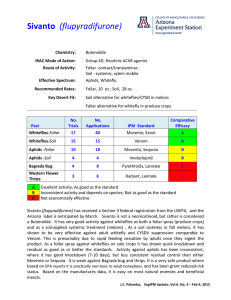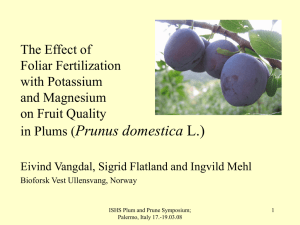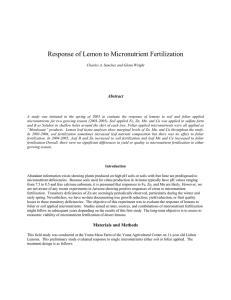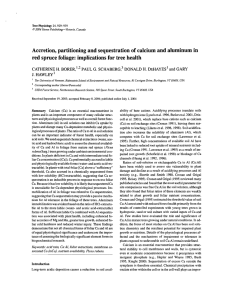Continued Evaluation of N Fertilization Practices for Surface Irrigated Lemons Abstract
advertisement
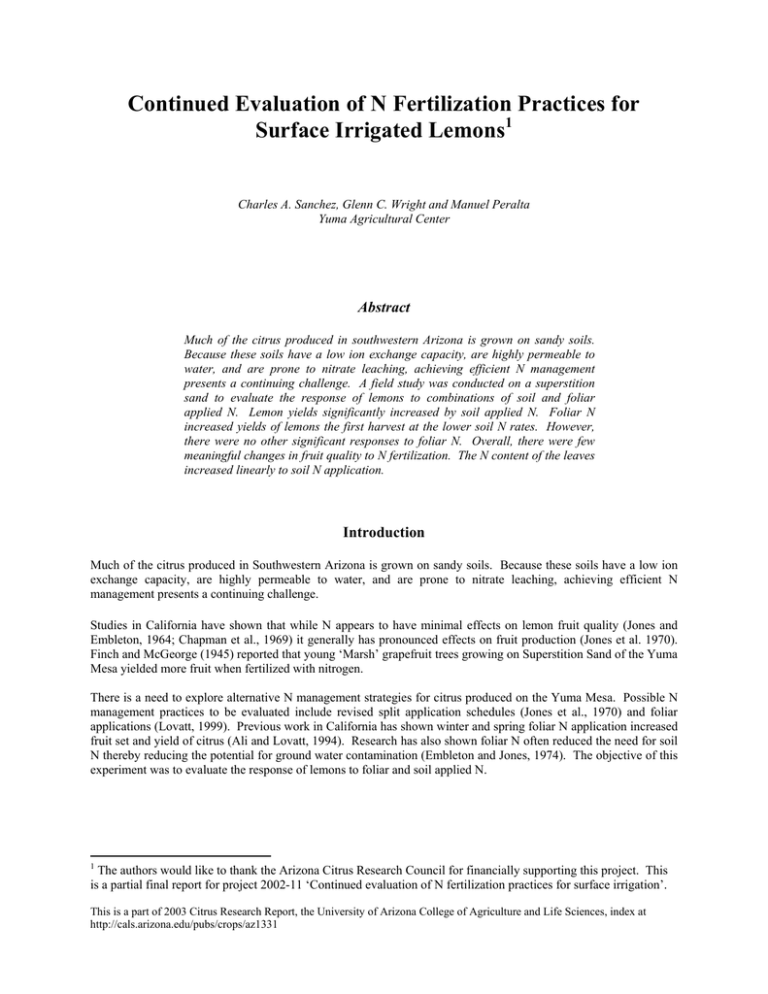
Continued Evaluation of N Fertilization Practices for Surface Irrigated Lemons1 Charles A. Sanchez, Glenn C. Wright and Manuel Peralta Yuma Agricultural Center Abstract Much of the citrus produced in southwestern Arizona is grown on sandy soils. Because these soils have a low ion exchange capacity, are highly permeable to water, and are prone to nitrate leaching, achieving efficient N management presents a continuing challenge. A field study was conducted on a superstition sand to evaluate the response of lemons to combinations of soil and foliar applied N. Lemon yields significantly increased by soil applied N. Foliar N increased yields of lemons the first harvest at the lower soil N rates. However, there were no other significant responses to foliar N. Overall, there were few meaningful changes in fruit quality to N fertilization. The N content of the leaves increased linearly to soil N application. Introduction Much of the citrus produced in Southwestern Arizona is grown on sandy soils. Because these soils have a low ion exchange capacity, are highly permeable to water, and are prone to nitrate leaching, achieving efficient N management presents a continuing challenge. Studies in California have shown that while N appears to have minimal effects on lemon fruit quality (Jones and Embleton, 1964; Chapman et al., 1969) it generally has pronounced effects on fruit production (Jones et al. 1970). Finch and McGeorge (1945) reported that young ‘Marsh’ grapefruit trees growing on Superstition Sand of the Yuma Mesa yielded more fruit when fertilized with nitrogen. There is a need to explore alternative N management strategies for citrus produced on the Yuma Mesa. Possible N management practices to be evaluated include revised split application schedules (Jones et al., 1970) and foliar applications (Lovatt, 1999). Previous work in California has shown winter and spring foliar N application increased fruit set and yield of citrus (Ali and Lovatt, 1994). Research has also shown foliar N often reduced the need for soil N thereby reducing the potential for ground water contamination (Embleton and Jones, 1974). The objective of this experiment was to evaluate the response of lemons to foliar and soil applied N. 1 The authors would like to thank the Arizona Citrus Research Council for financially supporting this project. This is a partial final report for project 2002-11 ‘Continued evaluation of N fertilization practices for surface irrigation’. This is a part of 2003 Citrus Research Report, the University of Arizona College of Agriculture and Life Sciences, index at http://cals.arizona.edu/pubs/crops/az1331 Materials and Methods A field study was conducted on Superstition Sand to evaluate the response of lemons to combinations of soil and foliar applied N. The treatments were as follows: 1. 2. 3. 4. 5. 6. 7. 8. 9. Soil Applied N (lbs/tree/yr) 0 0 0 1.5 1.5 1.5 3.0 3.0 3.0 Foliar N (lbs/tree/yr) 0 0.25 0.50 0 0.25 0.50 0 0.25 0.50 Urea was used for all soil application and low-biuret urea was used for foliar application. Soil application was split into six applications that occurred on January 15, February 15, March 14, April 11, May 13, and June 19. For soil application, urea was applied by hand around the base of each tree. Foliar application rates were 0.25 lbs/A. The single application (treatments 2, 5, and 8) were applied January 15. The double application (treatments 3, 6, and 9) were applied January 15 and March 15. Leaf samples were collected August 13. At maturity lemon yield and quality were determined using standard techniques. Lemons were harvested October 10, November 15, and February 4. Results and Discussion Lemon yields significantly increased each harvest by soil applied N (Table 1). In this study it appears the 1.5 lb N/tree rate was sufficient for maximum yield. There was a statistically significant interaction between soil applied N and foliar applied N for the first harvest. Generally, foliar N increased yields of lemons this first harvest at the lower soil N rates. There were no other significant responses to foliar N. Overall, there were few meaningful changes in fruit quality to N fertilization (Table 2). It appears percent solids and solid to acid ratio increased with both soil and foliar N fertilization but the differences were small and of minimal practical importance. The N content of the leaves increased linearly to soil N application (Table 3). However, there were no significant differences due to foliar applied N or significant soil applied N by foliar N interactions. Previous research has suggested the critical N content of lemons leaves to be 2.2 to 2.5% (Jones et al., 1970). Interestingly, the N concentration associated with maximum yields in these experiments was 1.89%. Additional work is needed to reevaluate critical leaf N concentrations for lemon cultivars currently produced on the Yuma Mesa. Literature Cited Ali, A. G., and Lovett. 1994. Winter application of low Biuret urea to the foliage of Washington Navel orange increased yield. J. Amer. Soc. Hort. Sci.119:1144-1150. Chapman, H. D., H. Joseph, and D. S. Rayner. 1969. Nitrogen nutrition in young lemons. Citrograph 54:192196,198-200. Embleton, T. W., and W. W. Jones. 1974. Foliar applied nitrogen for citrus fertilization. J. Environ. Qual. 3:338392. Finch, A. H., and W. T. McGeorge. 1945. Fruiting and physiological responses of Marsh grapefruit trees to fertilization. Univ. of Arizona Tech. Bull. 105:428-454. Jones, W. W., and T. W. Embleton. 1964. Relation of nitrogen nutrition to lemon production. Calif. Citrograph 49:267, 276. Lovett, C. J. Timing citrus and avocado foliar nutrient applications to increase fruit set and size. HortTechnology 9:607-612. Rodney, D. R., and G. C. Sharples. 1962. Responses of ‘Lisbon’ lemon trees to applications of nitrogen, phosphate, and manure. Proc. Amer. Soc. Hort. Sci. 78:181-185. Table 1. Main effect yield response of lemons to soil and foliar applied N fertilizer. Lemon Yield (lbs/tree) N Rate (lbs/tree) First Harvest Second Harvest Third Harvest Total 0 41.5 88.5 80.1 210.1 1.5 74.2 166.7 137.6 378.4 3.0 50.8 117.5 108.9 277.2 Stat. Q** L*Q*** L*Q*** L*Q*** Foliar N (lbs/tree) 0 44.2 108.5 98.0 0.25 62.7 137.5 125.5 0.50 59.6 126.7 103.1 Stat. NS NS Q* Interaction * NS NS *,**,***Linear (L) and Quadratic (Q) response at the 10, 1, and 0.1% levels, respectively. NS=Not significant Table 2. Quality responses of lemon to soil and foliar applied N fertilizer. N Rate Fruit weight Juice Solids Acid (%) Solid/Acid (lbs/tree) (g) (%) (%) Ratio 0 109.5 31.1 7.13 4.82 1.48 1.5 108.4 34.0 7.26 4.90 1.48 3.0 109.6 34.0 7.27 4.83 1.51 Stat. NS L** L* NS NS Foliar N (lbs/tree) 0 106.9 32.3 7.10 4.86 1.47 0.25 110.1 33.6 7.28 4.93 1.48 0.50 110.5 33.1 7.27 4.77 1.53 Stat. NS NS L* NS L* Interaction NS * NS NS NS *,**,***Linear (L) and Quadratic (Q) response at the 10, 1, and 0.1% levels, respectively. NS=Not significant Table 3. Nitrogen content of lemon leaves as affected by soil and foliar N fertilization. N Rate (lbs/tree) Leaf N content (%) 0 1.55 1.5 1.89 3.0 2.04 Stat. L*** Foliar N (lbs/tree) 0 1.83 0.25 1.79 0.50 1.84 Stat. NS Interaction NS *,**,***Linear (L) and Quadratic (Q) response at the 10, 1, and 0.1% levels, respectively. NS=Not significant 250.6 325.7 289.4 NS NS Peel Thickness 4.63 4.71 4.80 NS 4.69 4.49 4.97 NS NS
